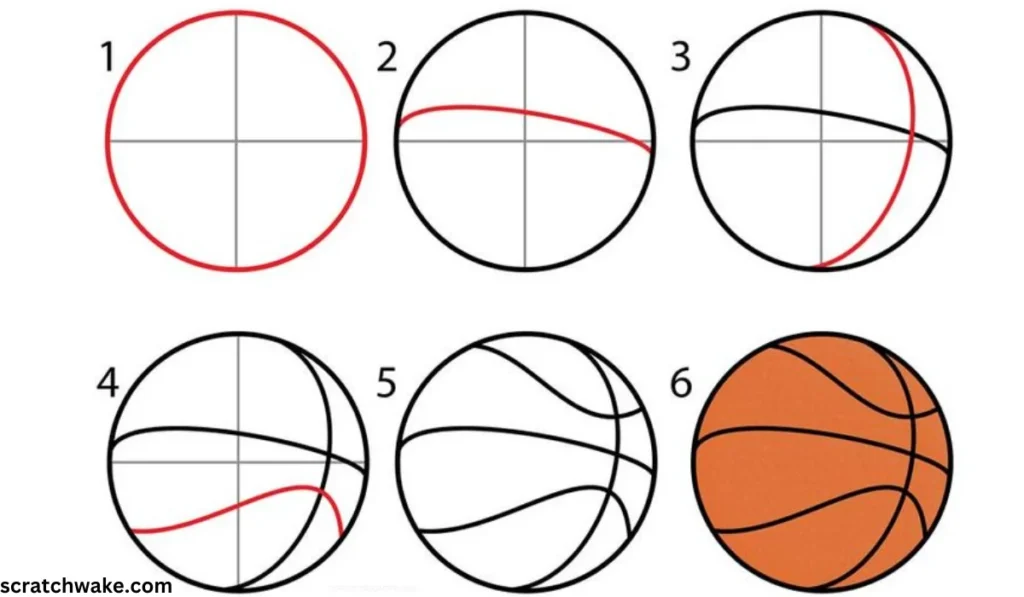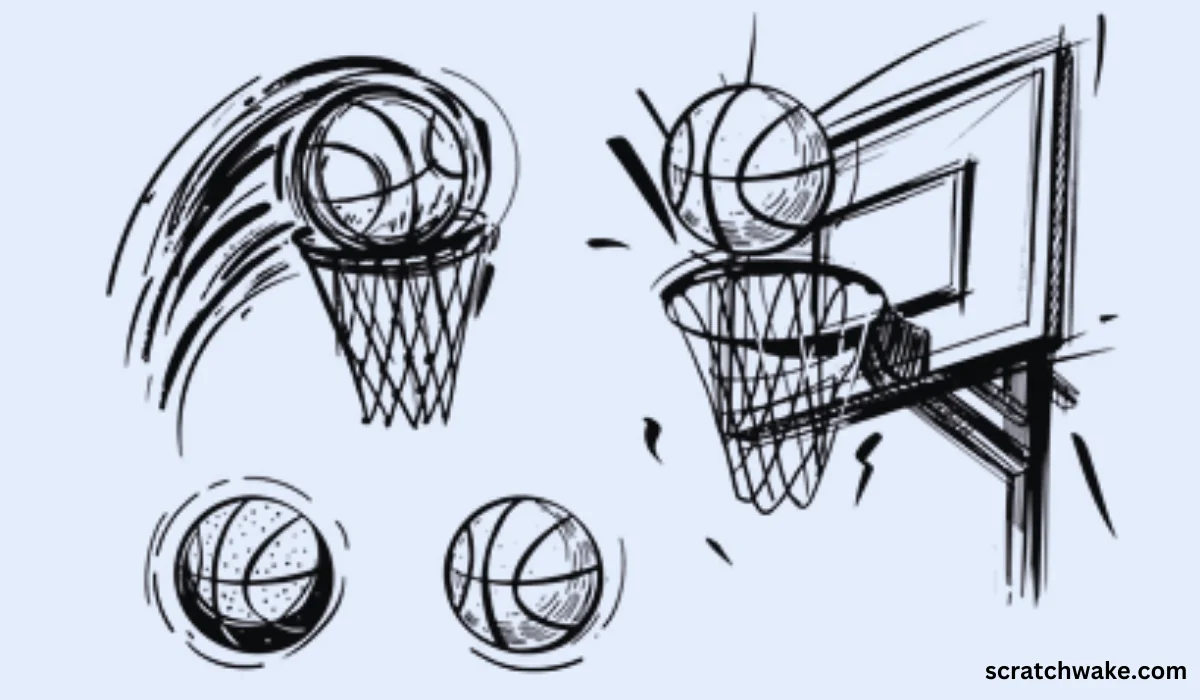Drawing basketball is more than just putting pencil to paper; it’s about capturing the excitement and energy of one of the most dynamic sports in the world. Whether you’re a fan or an aspiring artist, translating that fast-paced action into art can be both challenging and rewarding. The way players leap for a slam dunk or dash across the court embodies movement, strength, and grace—all elements that make for a stunning piece of artwork. If you’re ready to explore your artistic side while celebrating this beloved sport, grab your Sketchbook! Let’s dive into techniques and tips that will elevate your drawings from simple sketches to vibrant portrayals of athleticism on the hardwood floor.
About Basketball
Basketball, a fast-paced sport, captivates millions around the globe. It combines athleticism with strategy, allowing players to showcase their skills on and off the court.
Originating in 1891, basketball was created by Dr. James Naismith as a way to keep students active indoors during winter months. Today, it has evolved into an international phenomenon.
The game is played between two teams of five players each. The objective is simple: score points by shooting a ball through the opposing team’s hoop. This dynamic sport requires quick thinking and teamwork.
From street courts to professional arenas like the NBA, basketball unites diverse cultures and backgrounds. Fans rally behind their favorite teams, creating an electric atmosphere that adds to its appeal.
Whether you’re watching or playing, there’s always something thrilling about basketball—a dance of skill and instinct that keeps everyone on their toes.
Understanding the Anatomy of a Basketball Player
Understanding the anatomy of a basketball player is crucial for artists aiming to capture dynamic movement. The human form in action presents unique challenges and opportunities.
Focus on key muscle groups that define athleticism. Strong legs propel players into jumps, while powerful arms are essential for shooting and passing.
Pay attention to proportions too. Basketball players often have longer limbs and larger hands than average individuals, which influences their poses and movements.
Study the torso’s twist during dribbling or shooting; it reflects balance and strength. Each position requires a different muscular engagement, highlighting tension or relaxation.
Don’t forget about facial expressions—intense concentration or jubilation can add life to your drawings. Capturing these nuances will elevate your artwork beyond mere representation.
Read More: Denver Nuggets vs Dallas Mavericks Match Player Stats
Drawing for Basketball


Drawing for basketball transcends mere representation. It’s about capturing the essence of movement, energy, and emotion that defines the sport.
When you set your pencil to paper, think about the dynamic poses players assume. Each dribble or jump tells a story waiting to be illustrated. Focus on their expressions, as each player showcases determination and passion.
Consider how angles play a significant role in conveying action. A lower perspective can add drama; an overhead view offers context. Experiment with different viewpoints to find what resonates best with your style.
Don’t forget about teamwork elements too! Illustrating multiple players interacting adds depth and narrative richness to your artwork.
Remember that practice is key in mastering this unique art form. Explore various techniques until you discover what feels right for you as an artist passionate about basketball’s vibrant culture.
Tools and Materials Needed for Drawing Basketball
When diving into drawing basketball, having the right tools can make a world of difference. Start with high-quality pencils. Graphite pencils in various hardness levels help you create detailed lines and shadows.
Next, consider sketching paper. Choose a medium that can handle erasing without damaging the surface. Smooth bristol board is an excellent option for clean lines and vibrant colors.
Markers or fine liners are great for adding bold outlines to your sketches. They give your drawings depth and definition.
For those who enjoy color, invest in colored pencils or watercolors to bring life to your artwork. Experimentation will lead you to find what works best for you.
Don’t forget about erasers! A kneaded eraser allows for gentle corrections while preserving your paper’s texture. With these essentials on hand, you’re ready to capture the dynamic essence of basketball through art.
Step-by-Step Guide to Drawing a Basketball Player
Start with a light sketch. Use simple shapes to outline the head, torso, arms, and legs. This will help you get a sense of proportions and pose.
Next, refine the body structure by adding muscle definitions and clothing details. Focus on the unique aspects of basketball attire, like shorts and sneakers.
Once you’re satisfied with the basic form, move on to facial features. Capture expressions that reflect concentration or excitement—this adds life to your drawing.
After establishing the figure’s outline, begin detailing limbs in motion. Pay attention to angles; fingers gripping a ball or feet poised for a jump can create dynamic energy.
Finalize with clean lines and erasing any unnecessary sketches. You’re ready to add color if desired or enhance shading for depth!
Tips for Capturing Movement and Action in Your Drawings
Capturing movement in your drawings can elevate your artwork to new heights. Start by studying the dynamics of a basketball game. Observe players in action—running, jumping, and shooting.
Use quick sketches to practice fluid lines that convey motion. Don’t aim for perfection; focus on the essence of the pose instead.
Incorporate dynamic angles into your work. A low viewpoint can enhance a player’s leap, while an overhead angle captures teamwork effectively.
Experiment with gesture drawing techniques. These allow you to capture the energy and rhythm of play without getting bogged down by details.
Consider using blurred lines or overlapping shapes to emphasize speed. This technique can create a sense of urgency in your illustrations.
Remember that every player has their unique style and flow. Embrace these nuances as you draw them in action for added authenticity.
Also Read: Boston Celtics vs Philadelphia 76ers Match Player Stats
Adding Details and Shadows to Enhance Realism
Adding details and shadows can transform a flat drawing into a dynamic piece of art. Subtle touches make all the difference.
Start with the highlights. Notice how light interacts with the player’s body, reflecting off their skin or jersey. Use lighter shades to emphasize these areas, creating depth.
Next, consider shadows. They ground your subject in space and add dimension. Observe where natural shadows fall on basketball players—underneath arms, along legs, or behind the ball during motion.
Textures also contribute to realism. Pay attention to fabric folds in jerseys and sneakers’ surfaces. Capturing these nuances enhances lifelike quality.
Don’t forget about facial expressions! A furrowed brow or clenched jaw can convey intense concentration or determination.
Each detail matters; they weave together to create an engaging narrative within your artwork that draws viewers into the action of basketball.
Common Mistakes to Avoid When Drawing Basketball Players
One common mistake many artists make is neglecting proper proportions. Basketball players are tall and lean, so it’s crucial to capture this height accurately. Skipping the initial sketch phase can lead to awkward postures.
Another frequent error involves overlooking body language. Each movement tells a story—whether shooting or dribbling, subtle details matter. Pay attention to how limbs extend during actions.
Ignoring perspective is also problematic. A slight tilt in the angle of view can add depth and excitement to your work but requires practice to master.
Many artists forget about facial expressions too. The intensity on a player’s face while making a basket adds life and emotion that enhances any drawing.
Don’t rush through adding shadows and highlights. These elements define muscle tone and create realism, making your drawings pop off the page with energy.
Using References and Practicing to Improve Your Skills
Using references is a game-changer for artists. Observing real-life basketball players in action can enhance your understanding of form and movement. Photos, videos, or live games are excellent sources.
Practice makes perfect. The more you draw, the better you’ll become at capturing dynamic poses. Start with simple sketches before tackling complex scenes.
Don’t shy away from studying anatomy too. Knowing muscle groups helps create realistic figures that convey strength and agility.
Try drawing different scenarios—dribbling, shooting, or defending—to diversify your skills. Each position presents unique challenges.
Join online communities or local art clubs where feedback flows freely. Sharing your work can provide new perspectives and motivate improvement.
Keep a sketchbook handy to jot down ideas whenever inspiration strikes. Consistent practice shapes style over time while reinforcing techniques learned from references.
Conclusion
Drawing basketball players can be an exciting journey. It allows artists to explore movement and emotion through their craft.
Experimenting with different techniques opens up new avenues for creativity. Don’t hesitate to try various styles, from realism to abstract interpretations.
Practicing consistently will sharpen your skills over time. Each sketch brings you closer to mastering the representation of athletes in action.
Incorporating feedback from fellow artists can provide fresh perspectives and growth opportunities. Embrace constructive criticism as a tool for improvement.
Remember that every artist has their unique approach. Your personal style will develop as you continue drawing basketball scenes and players.
Enjoy the process, whether capturing a slam dunk or a moment of concentration before a free throw. The beauty lies in both the art created and the passion behind it.
FAQs
1. What are the best tools for drawing basketball players?
When it comes to drawing basketball players, basic sketching supplies like pencils, erasers, and paper work well. For more advanced details, consider using colored pencils or markers. Some artists prefer digital tools like graphic tablets for flexibility.
2. How can I improve my skills in drawing basketball?
Practice is key! Regularly sketch different poses and movements from reference images or videos of players in action. Join online art communities where you can share your work and receive constructive feedback.
3. Should I focus on realistic drawings or stylized versions of basketball players?
It depends on your artistic preference. Both styles have their merits. Realistic drawings capture the essence of the sport, while stylized versions allow for creativity and personal expression.
4. What resources are available for learning how to draw basketball figures?
There are various online tutorials, YouTube channels dedicated to art instruction, and books focused specifically on figure drawing that include sports themes. Explore these mediums to find what resonates with you.
5. Can I use photographs as references when drawing basketball players?
Absolutely! Using photographs as references can help you understand proportions better and capture dynamic poses accurately. Just be sure to add your unique touch to avoid replicating someone else’s work directly.
6. Where can I showcase my finished drawings of basketball players?
You can share your artwork on social media platforms such as Instagram or Pinterest under hashtags related to sports art or figure drawing. Additionally, consider joining local art shows or exhibitions focused on sports-themed artwork.




